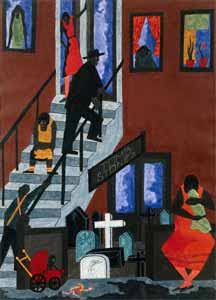|
|
 |
 |
 |

Click here to view a larger image |
Tombstones,
1942. Gouache on paper, 28 3/4 x 22 1/2 in. (73 x 57.2 cm). Whitney
Museum of American Art, New York; purchase 43.14
Artwork © Gwendolyn Knight Lawrence, courtesy of the Jacob and
Gwendolyn Lawrence Foundation |
| |
|
 |
The strength of
family and community bonds was tested by the many threats to healthy
living that the migrants encountered in the urban North. Limited access
to health care and hospital facilities was a major problem for blacks
in northern cities. Smallpox, tuberculosis, pneumonia, and other diseases
spread quickly. The death rate for blacks was consistently higher
than that for whites.1
This painting appears to depict an everyday Harlem scene of men, women,
and children relaxing on and around a stoop on a hot day in the city.
On closer examination, Lawrence has made symbolic and religious references
to the cycle of birth, life, and death. On the right, a woman holds
a baby, like a Madonna and child. The diagonal lines and shapes of
the stoop and tombstone sign draw attention to the door and windows
at the top of the painting. The potted plants in the window (top right)
also suggest different stages of growth.
SYMBOL
A symbol is something–usually a sign or an object–that represents
or stands for something else. For example, flags can be symbols for
countries and hearts are often symbols for love.
1. Carole Marks, Farewell–We're Good
and Gone: The Great Black Migration (Bloomington, Indiana: Indiana
University Press, 1989), p. 147. |
|
|

• Compare this image to Lawrence's 1958  Brownstones.
List the similarities and differences that you find in these paintings.
Pay attention to shapes and colors. Notice what the figures are doing and
what their gestures are. How do stoops play a role in both images? What
messages do these images communicate about the Harlem community?
Brownstones.
List the similarities and differences that you find in these paintings.
Pay attention to shapes and colors. Notice what the figures are doing and
what their gestures are. How do stoops play a role in both images? What
messages do these images communicate about the Harlem community? |









